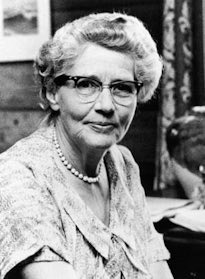The daughter of a Harvard economics professor, Helen Taussig lost her mother to tuberculosis when she was only eleven. Her father became the most important influence in her early years, and he encouraged her professional goals. Excluded from Harvard Medical School because of her sex, she went to Johns Hopkins instead and became interested in the field of cardiology.
As chief of the heart clinic at Johns Hopkins she regularly saw children born with heart defects. The most pathetic were the cyanotic, or “blue babies,” condemned to invalidism and early death. Dr. Taussig began to theorize about the nature of the anatomical defects involved, and to devise possible surgical solutions.
Together with a heart surgeon named Blalock, she pioneered the Blalock-Taussig operation, first performed in 1944. The first patient was a one-year old child who weighed just 10 pounds. Dr. Taussig had the thrill of seeing the child develop a healthy pink color for the first time. The operation soon became widely performed. Her medical breakthrough combined caring and inventiveness, and many infants won the chance for a normal life.

